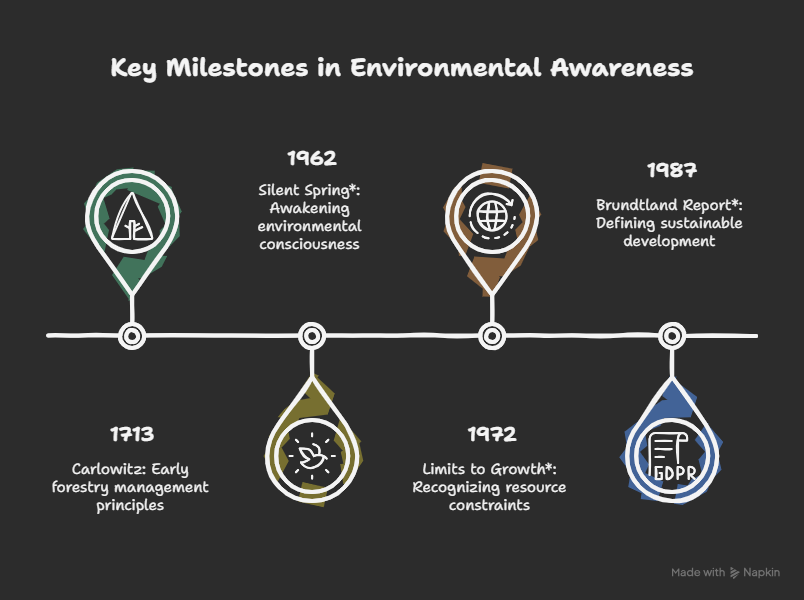What is Sustainibility?
1. Historical Origins & Key Influencers
While the idea of living within limits is ancient, the modern sustainability movement has more recent roots.
- 18th Century: Earliest mention by Hans Carl Von Carlowitz in the context of "sustainable forestry."
- Post-WWII (1960s-70s): The movement gained significant traction due to rising concerns about pollution, nuclear energy, and ecological risks.
Key Pioneers & Publications:
| Pioneer / Group | Contribution / Publication | Year | Core Idea |
|---|---|---|---|
| Rachel Carson | Silent Spring (Book) | 1962 | Directly linked environmental damage (e.g., pesticides) to human health and well-being. |
| E.F. Schumacher & Herman Daly | Economic Theories | - | Argued that economies are subsystems of the finite environment and must respect its limits. |
| The Club of Rome | Limits to Growth (Report) | 1972 | Introduced systems thinking to model the interplay between global resources, population, and pollution. |
2. The Brundtland Report: A Milestone Definition
This is arguably the most cited and foundational definition in the field.
- Official Title: "Our Common Future"
- Published By: The UN World Commission on Environment and Development
- Year: 1987
- Canonical Definition: "Sustainable development is development that meets the needs of the present without compromising the ability of future generations to meet their own needs."
Core Components of the Brundtland Definition:
- Intra-generational Equity: Meeting the needs of the present, with a particular focus on the world's most vulnerable populations.
- Inter-generational Equity: Ensuring that the actions of the current generation do not deplete resources or degrade the environment for future generations.
3. Four Core Ideas of Sustainability (Framework by Jeremy Caradonna)
This framework synthesizes the key principles running through most sustainability thinking.
- Interconnection: The economy, human society, and the natural environment are deeply interconnected systems.
- Ecological Limits: Human societies must operate within the finite limits of the planet's ecosystems to persist over time.
- Future-Oriented Planning: A focus on long-term thinking is essential, moving beyond immediate needs and profits.
- Local & Small-Scale Solutions: These are often more resilient and adaptable than large, centralized systems.
4. Alternative Definitions & Perspectives
It's important to know that there is no single, universal definition. Different definitions highlight different priorities.
- Oxford English Dictionary: Focuses on resource management – "avoiding long-term depletion of natural resources."
- Caradonna (cited): Focuses on lifestyle – a "lifestyle designed for permanence."
- University of British Columbia (UBC): A proactive and positive approach – "simultaneous improvements in human and environmental wellbeing," not just reducing harm.
5. A Critical Note on the Narrative
- The dominant historical narrative of sustainability has been shaped by sources from Europe and North America.
- Modern sustainability efforts are actively working to include marginalized voices and traditional knowledge from indigenous cultures and the Global South.
Exam Tip: The Brundtland Report's definition is essential; you must be able to state it accurately and explain the concepts of intra- and inter-generational equity. Also, be prepared to list and briefly explain Caradonna's four core ideas of sustainability.


No Comments